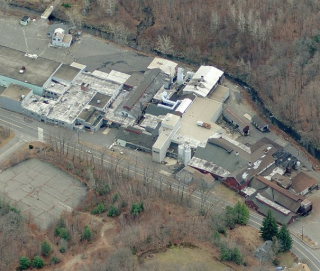Mill Record Plymouth
RETURN TO ‘FIND MILLS’Disclaimer: Content for these properties was compiled in 2014-2017 from a variety of sources and is subject to change. Updates are occasionally made under Property Information, however the Connecticut Trust for Historic Preservation (dba Preservation Connecticut) makes no representation or warranty that the information is complete or up-to-date.
- Complex Name (Common)
- Andrew Terry Co.
- Complex Name (Historic)
-
- Andrew Terry Co.
- O.A. Gedney Electrical Co.
- Address or Location
- 100 South Riverside Avenue, Terryville, Plymouth
- County
- Litchfield
- Historic Designation
- Associated Mill Community

- Historic Information
Companies Associated w/Complex
- Andrew Terry Company c.1870-c.1960
- Malleable Iron Works 1847-c.1870
- O.Z. Gedney Company c.1960-c.1990
Use (Historic)
Largest Documented Workforce
200 (c.1945)
Historic Narrative
In 1847, Andrew Terry (1824-1877) established the Malleable Iron Works, a small forge shop employing about twenty men on the Pequabuck River in the Terryville section of town. Terry was the grandson of clock maker Eli Terry, and the brother of James Terry, the first president of the Eagle Lock Company, also in Plymouth. Around 1860, Terry formed a joint stock corporation with two partners, and the company was renamed the Andrew Terry Co. The partners bought Terry out c.1870, after which, in 1875, he founded the Bristol Foundry Company (later the Sessions Foundry Company supplying hardware for Sessions and Son in Bristol). The dam at Horseshoe Falls along Canal Street was built to power the factory, and the factory complex burned down and was rebuilt at some time prior to 1895. By the 1890s, the company was melting about 6 tons of iron daily, using six furnaces, eight annealing furnaces and two cupolas for melting ore. During the Second World War, the peak of operations, the firm employed some 200 people. By 1960, Andrew Terry Company merged with the Gedney Electric Co., manufacturers of electrical fittings, and in the 1970s was bought by General Signal Corporation, of Stamford, CT, to become the O-Z Gedney Company. Production continued at the site until the 1990s. The foundry produced gray iron castings, including carriage, car, harness and scythe trimmings, wrenches, and in the 20th century a cast metal cable device for elevators.
- Architectural Information
Number of Existing Buildings
Nine (9) primary blocks.
Dates of Construction
c.1900 -1940
Architect
n/a
Builder
n/a
Building Type
Architectural Description
Several of the buildings have been demolished within the last few years; nine major building sections remain, all of which were built prior to 1908, with the exception of the post-1940s two-story concrete building on the eastern end of the property. At the western end of the complex is a one-story casting shed with monitor roof. Attached perpendicularly to the east is a one-story production shed with gable roof. Further east is a wider production shed with monitor roof. Detached to the north along South Riverside Avenue are the office (western gable roof building) and pattern storage (eastern flat roof building). A small free standing gable roof storage shed sits to the southeast along the river. The next building built prior to 1908 is a monitor roof structure surrounded by post-1940s modern infill additions at the center of the complex, with a smaller monitor roof structure to the northeast and a one-story production shed with monitor roof to the southeast.
Exterior Material(s)
Structural System(s)
Roof Form
Roof Material
Power Source
Condition
Good, Fair, Deteriorated
Condition Notes
All portions of the building are in generally good condition.
- Property Information
-
Specific Location
One 18 acre parcel at the southern end of William Street, south of South Riverside Avenue and north of the Pequabuck River.
Adjacent To
Exterior Visible from Public Road?
Yes
Parcel ID / Assessor Record Link
- 00323800 five cards / Link →
Acreage
18
Use (Present)
- Sources
-
Form Completed By
Mike Forino
Date
n/a
Bibliography
- 1947 Industrial Directory of Connecticut.
- History of the Town of Plymouth Connecticut, Francis Atwater, 1895 Journal Publishing Co. Meriden.
- The Hartford Courant, 1877-1960.
- Sanborn Fire Insurance Maps, Terryville, 1908-1942.
- Representative View(s)Click on image to view full file









